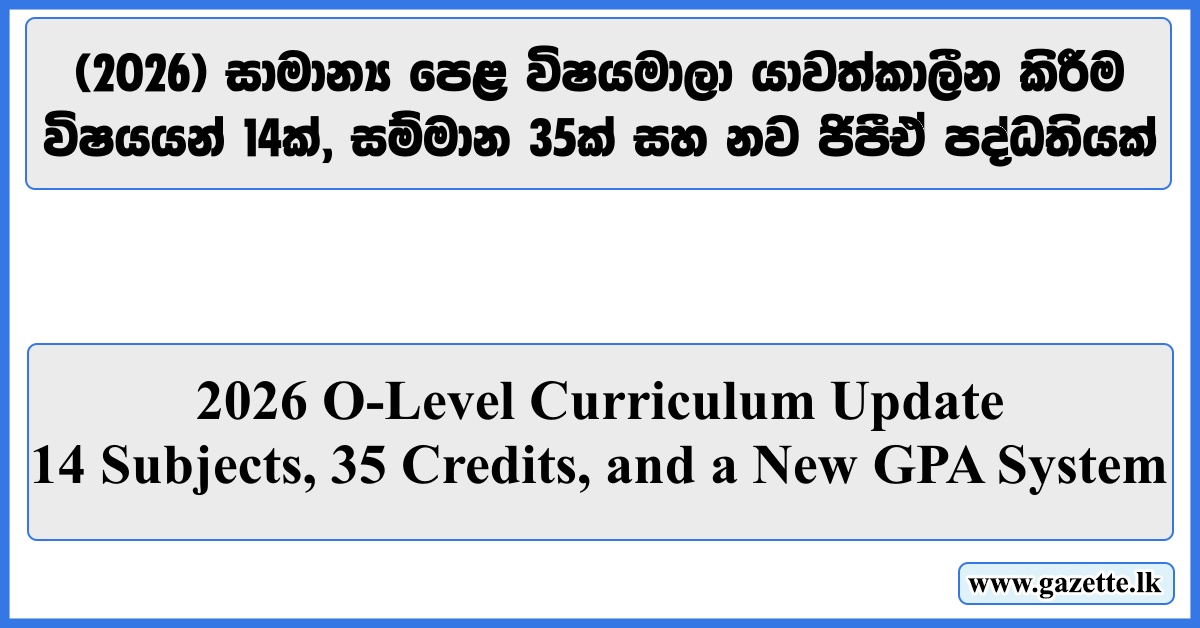The 2026 education reforms of Sri Lanka do have a major turning point with regards to the curriculum of the Ordinary Level (O/L). The new system is intended to be more varied, future-oriented, and academically aware of the fact that it will provide students with more subjects, credit-based system and grading changes to GPA based.
Curriculum Overview
In the new structure, students will be put under a 14-subject curriculum, thus having a broad and balanced education. Nevertheless, these subjects will be limited to 7 in the O-Level which will be public. The remaining 7 subjects form part of a further education curriculum that supports skill development, career readiness, and advanced study preparation.
Breakdown:
- Total Subjects Studied: 14
- Subjects in O/L Exam: 7
- Non-Exam Subjects: 7
Subjects in the New O/L Curriculum
Compulsory Subjects (5)
- Mother Tongue (Sinhala/Tamil)
- English
- Mathematics
- Science
- Religion & Values Studies
Elective Subjects (Select 2)
- Second National Language
- Information & Communication Technology (ICT)
- History
- Civic Education
- Health & Physical Education
- Geography
- Technology
- Aesthetic Education
- Entrepreneurship & Financial Literacy
These 7 subjects (5 compulsory + 2 electives) are assessed in the national O-Level examination.
The Further Education Curriculum (7 Non-Exam Subjects)
The other 7 subjects are meant to help the students to fit in different A-Level stages and career work lives. These are compulsory subjects although not analyzed in the public O/L exam and they are grouped under major themes:
STEM (Science, Technology, Engineering, Mathematics)
Humanities and Social Sciences
Management
Vocational Training Subjects
- Construction & Infrastructure
- Creative Industries
- Primary Industries
- Social & Communication Services
- Manufacturing & Technology
These subjects are selected based on a student’s preferred stream at A-Level and career interests.
Credit-Based System: 35 Credits Per Semester
The new curriculum adopts a credit system to quantify the workload of each subject, including class time, self-study, and assessments. Each semester totals 35 credits.
Credit Allocation:
| Subject Type | Credits |
|---|---|
| Mother Tongue | 3 |
| English | 3 |
| Mathematics | 3 |
| Science | 3 |
| Religion & Values Studies | 2 |
| 2 Electives | 2 credits each (4 total) |
| Total for Exam Subjects | 18 Credits |
| 7 Non-Exam Subjects | 2 credits each (14 total) |
| Transversal Skills Group | 3 |
| Grand Total | 35 Credits per Semester |
Transversal Skills Curriculum
A new Transversal Skills Group is included, focusing on soft skills and modern competencies. Topics may include:
- Media and Communication
- Digital Citizenship
- Global Awareness
- Health & Sports
- Environmental Literacy
These are evaluated internally and are essential for overall student development.
Introducing the GPA System
The new model replaces the conventional A-F grading system with a Grade Point Average (GPA) scale, which is at the same level with international standards.
Proposed GPA Scale:
| Score (%) | GPA |
|---|---|
| 90–100% | 4.0 |
| 80–89% | 3.7 |
| 70–79% | 3.3 |
| 60–69% | 3.0 |
| 50–59% | 2.7 |
| 40–49% | 2.0 (Pass) |
| Below 40% | 0.0 (Fail) |
The GPA is also determined as the average of GPA points of all school subjects thus encouraging filed assessment and stability in academics.
Assessment Methods
Two layers of evaluation are built into the new system:
- Learning Module-Based Assessments
- Conducted internally by schools to monitor ongoing progress.
- National O-Level Examination
- Administered externally for the 7 exam subjects.
School Day Structure (Also Revised)
In a bid to accommodate the new curriculum, the new school day will have 7 learning periods (50 minutes each), giving an additional 30 minutes to the school routine in a day. This helps to have enough time in the exam and non-exam subjects.
Key Highlights – At a Glance
- Students follow a 14-subject curriculum.
- Only 7 subjects are part of the national O/L exam.
- The remaining 7 subjects focus on career and A-Level readiness.
- Each semester includes 35 credits.
- A GPA system replaces letter grading.
- A revised daily timetable supports the expanded learning structure.
Note: Curriculum details may be updated as implementation progresses.


